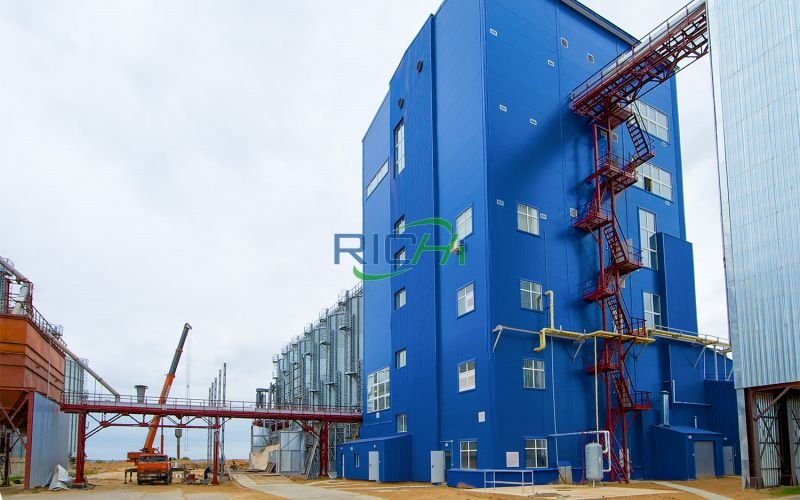Premix feed mills play a crucial role in the animal nutrition industry by producing concentrated blends of vitamins, minerals, and other essential nutrients. These premixes are designed to be incorporated into complete animal feeds at low inclusion rates, typically ranging from 0.5% to 5% of the total feed composition. This article outlines the key steps involved in the production process of a premix feed mill, ensuring the delivery of high-quality, nutrient-rich products.
1. Raw Material Selection and Procurement
The first step in the production process is selecting and procuring high-quality raw materials. These materials include:
- Vitamins (A, D, E, K, B-complex, C)
- Minerals (calcium, phosphorus, magnesium, sodium, potassium, iron, zinc, copper, manganese, selenium, iodine)
- Amino acids (lysine, methionine, threonine, tryptophan)
- Enzymes (phytases, carbohydrases, proteases)
- Probiotics and prebiotics
- Antioxidants
- Acidifiers
- Mycotoxin binders
Procurement involves sourcing these ingredients from reputable suppliers, ensuring they meet the required quality standards and are free from contaminants.
2. Quality Control and Testing
Upon arrival at the premix feed mill, raw materials undergo rigorous quality control and testing. This step ensures that only high-quality ingredients are used in the production process. Key tests include:
- Nutrient analysis to verify the content of vitamins, minerals, and other nutrients
- Microbiological testing to detect any harmful pathogens
- Physical inspection for color, odor, and texture
- Chemical analysis to identify any contaminants or impurities
Related post: 12 T/H Premix Feed Mill in United States
3. Ingredient Storage
After passing quality control, raw materials are stored in designated storage areas. Proper storage conditions are essential to maintain the integrity and stability of the ingredients. This includes:
- Temperature control to prevent degradation of heat-sensitive vitamins and enzymes
- Humidity control to prevent moisture absorption and clumping
- Protection from light to avoid degradation of light-sensitive nutrients
4. Weighing and Dosing
Accurate weighing and dosing of ingredients are critical to ensure the correct formulation of the premix. This step involves:
- Using precision scales to weigh each ingredient according to the formulation
- Automated dosing systems to ensure consistent and accurate measurements
- Recording the weights and batch numbers for traceability and quality control
5. Mixing
Mixing is a crucial step in the production process, ensuring that all ingredients are evenly distributed throughout the premix. The mixing process typically involves two stages:
- Micro Mixing:
- Mixing small quantities of highly concentrated ingredients (e.g., vitamins, minerals, amino acids)
- Using specialized mixers designed for small batches to achieve a uniform blend
- Macro Mixing:
- Incorporating larger quantities of carrier materials (e.g., rice hulls, corn cobs) into the premix
- Using horizontal or rotary drum mixers to achieve a homogeneous mixture
Proper mixing is essential to achieve a low coefficient of variation (CV), indicating a uniform distribution of ingredients.
6. Quality Control and Sampling
After mixing, the premix undergoes further quality control and sampling to ensure consistency and compliance with specifications. This step includes:
- Taking representative samples from each batch
- Conducting nutrient analysis to verify the formulation
- Performing physical and chemical tests to ensure homogeneity and stability
7. Packaging
Once the premix passes quality control, it is packaged for distribution. Packaging involves:
- Using appropriate packaging materials to protect the premix from moisture, light, and contamination
- Automated bagging systems for efficient and accurate filling
- Sealing and labeling the packages with relevant information, including batch numbers, production dates, and ingredient lists
8. Storage and Distribution
Packaged premixes are stored in a designated storage area until they are ready for distribution. Proper storage conditions are maintained to preserve the quality of the premix. This includes:
- Temperature and humidity control
- Protection from pests and contaminants
- Organized storage to facilitate easy access and inventory management
Distribution involves transporting the premixes to feed manufacturers, farmers, or other end-users. Ensuring timely and efficient delivery is crucial to maintaining the quality and effectiveness of the premixes.
9. Documentation and Traceability
Throughout the production process, thorough documentation and traceability are maintained. This includes:
- Recording the source and batch numbers of raw materials
- Documenting the weighing, mixing, and packaging processes
- Keeping records of quality control tests and results
- Ensuring traceability of each batch from raw material to finished product
Documentation and traceability are essential for quality assurance, regulatory compliance, and addressing any potential issues or recalls.
10. Regulatory Compliance
Premix feed mills must comply with local and international regulations governing animal feed production. This includes:
- Adhering to Good Manufacturing Practices (GMP)
- Following Hazard Analysis and Critical Control Points (HACCP) principles
- Complying with specific regulations for feed additives and premixes
Regular audits and inspections by regulatory authorities ensure compliance and maintain the credibility of the premix feed mill.
Conclusion
The production process of a premix feed mill involves several critical steps, each contributing to the quality and effectiveness of the final product. From selecting and testing raw materials to mixing, packaging, and distribution, every stage requires meticulous attention to detail and adherence to strict quality control measures.By following these key steps, premix feed mills can produce high-quality, nutrient-rich premixes that enhance the nutritional content of animal feeds, supporting the health, growth, and productivity of livestock. As the demand for specialized and balanced animal nutrition continues to grow, premix feed mills play an essential role in meeting the needs of the agricultural industry and ensuring the well-being of animals worldwide.
For details please contact: Richi Machinery
WhatsApp:86 138 3838 9622
Email:enquiry@pellet-richi.com

